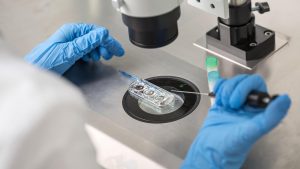Endometriosis is a painful and debilitating disorder that has been estimated to impact approximately 11% of women of reproductive age. The condition affects over 176 million women worldwide, and occurs when tissue similar to the lining of the uterus grows outside the womb, causing severe pain and fertility problems.
In some instances, the disease is so severe, women have needed complete hysterectomies.
There are four known stages of endometriosis, stage one being “minimal” and stage four being “severe”. Each stage can affect women in different ways, and it is important to be aware of the signs, how they affect you, and to know what you can do to help treat the condition if you are the one in ten women who suffer from the disease.
Stage one of endometriosis
According to the American Society for Reproductive Medicine (ASRM), stage one consists of small implants, lesions with minimal scarring and/or adhesions. Stage one is usually described as “minimal”, however it doesn’t necessarily mean that it’s painless and the symptoms aren’t noticeable.
During stage one, women may experience inflammation in or around the pelvic cavity and symptoms can vary depending on the location, the number, size and depth of the endometrial implants and adhesions.
Stage two of endometriosis
Stage two is considered “mild” and involves light lesions and shallow implants along the pelvic lining and around the ovaries. The implants in stage two usually measure around less than 5cm and compared the stage one, the implants may be deeper.
Stage three of endometriosis
Stage three endometriosis is usually considered “moderate”, where the implants are much deeper and may consist of more lesions.
Doctors have sometimes encountered endometrial cysts on at least one ovary, commonly referred to as “chocolate cysts” since they are filled with endometrial fluid and blood, giving it a brown colour. The cysts are caused by endometrial tissue which attaches the ovary and results in shedding blood and tissue.
Women who suffer from stage three endometriosis sometimes have filmy adhesions that can bind organs together when they shouldn’t be connected.
Stage four of endometriosis
The most severe stage of endometriosis is known as stage four, where deep implants within the pelvic lining and ovaries form, sometimes developing alongside large ovarian cysts.
In most cases of stage four endometriosis, the pelvis can appear so severely scarred that organs in the abdominal cavity are no longer mobile and can lead to excruciating pain along with significant fertility problems.
A way forward for patients with endometriosis
Having endometriosis doesn’t necessarily mean you will not be able to fall pregnant.
Although it’s a complex and sometimes debilitating disease, it is possible to achieve a healthy pregnancy. For more information on how we can help, contact our clinic on (02) 9586 3311 or email the Fertility First team.
Alternatively, you may want to check out some of the links and information below
What are the first signs of endometriosis?
Does diet help with the signs of endometriosis?
Endometriosis Awareness Month






